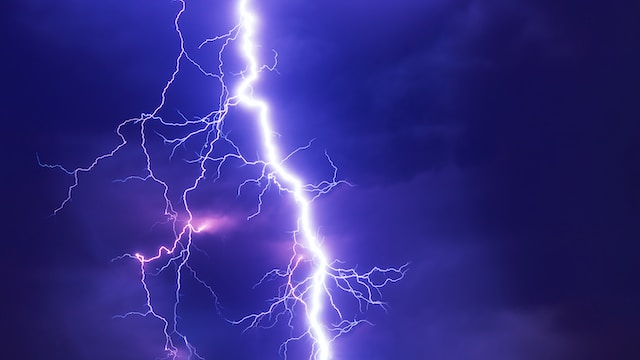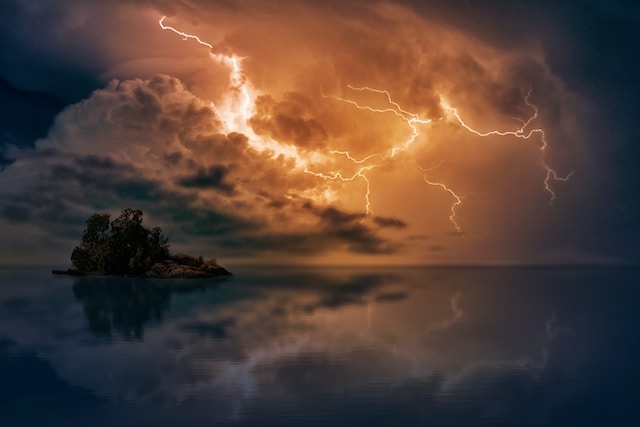Lightning occurs first and is the result of electrical discharges in the atmosphere. Thunder follows shortly after as sound waves travel through the air due to these discharges. Knowing this difference between lightning and thunder helps us understand more about how nature works, as well as serves a warning for when it’s time to seek shelter!
Lightning
(Photo by Felix Mittermeier on Unsplash)

Lightning is a naturally occurring electrical phenomenon that causes light in the sky during a thunderstorm. It typically occurs when warm air rises and cold air descends, creating an area of instability in the atmosphere. This can happen when a cold front moves through an area of warm, moist air. As the warm air rises, it cools and condenses into water vapor, which forms clouds. The rising air also creates an area of lower pressure beneath the clouds.
As the water vapor in the clouds continues to condense, it releases latent heat, which warms the air and makes it rise even faster. The rising air eventually reaches an area of stable atmospheric pressure and stop rising. At this point, the water droplets are forced together by gravity and begin to fall as rain.
The falling raindrops create friction as they interact with the particles in the atmosphere. This friction generates static electricity, which accumulates in the clouds until it becomes too great to be contained. When this happens, a lightning bolt is created as the electrical discharge seeks to equalize the charges between the cloud and ground.
Thunder
(Photo by Victor Chartin on Unsplash )

Thunder is the loud sound that accompanies lightning. When lightning strikes, it rapidly heats the air around it to a temperature of about 30,000 Kelvin (53,540 degrees Fahrenheit), which is hotter than the surface of the sun. This intense heat causes the air to rapidly expand, creating a shock wave that travels through the atmosphere as sound waves, which we hear as thunder.
The sound of thunder can vary depending on the distance from the lightning and the atmospheric conditions. Generally, the closer you are to the lightning strike, the louder and sharper the thunder will be. Thunder can also sound like a rumble or a series of rumbles if the lightning is far away or if there are multiple lightning strikes.
Thunder can also be dangerous, as it can indicate the presence of lightning, which is a significant hazard during thunderstorms. It is important to take precautions and seek shelter during a thunderstorm to avoid the potential danger of lightning strikes.
Difference between lightning and thunder
Lightning is a discharge of electricity that occurs when two charged objects come into close contact with each other. Thunder is the sound that accompanies lightning. It is caused by the expansion of air heated by the lightning.
How to stay safe during a thunderstorm
When thunderstorms occur, they can often be accompanied by heavy rain and strong winds. This can make driving conditions very dangerous. If you must drive during a thunderstorm, here are some tips to help keep you safe:
- The best way to stay safe during a thunderstorm is to avoid driving if possible. If you must drive, slow down and be extra cautious.
- Be on the lookout for flooded roads and areas of standing water. It only takes a few inches of water for your car to start hydroplaning, so it’s important to avoid any puddles or low-lying areas if possible.
- If you get caught in a thunderstorm while driving, pull over to the side of the road and turn off your car. Avoid touching any metal surfaces in the car, and stay inside until the storm passes.
- Don’t use your cell phone or any other electronic devices while driving. If you need to make a call, pull over to a safe location first.
- Use your headlights, even if it’s not raining or cloudy. This will help other drivers see your car, and it will also increase your visibility of potential hazards on the road.
What causes lightning to strike a person?
When lightning strikes a person, it is typically because that person is in the path of the strike. Lightning can travel through metal objects, so if someone is holding onto a metal pole or other metal object during a thunderstorm, they may be struck by lightning.
What are the types of lightning?
There are two types of lightning: cloud-to-ground and cloud-to-cloud. Cloud-to-ground lightning is the most common type, and it occurs when a negative charge in the bottom of a thunderstorm cloud (the cumulonimbus) transfers to the ground. This type of lightning can be particularly dangerous because it can strike anywhere that’s in contact with the ground, including people, buildings, and trees.
Cloud-to-cloud lightning is less common, but it can still be dangerous. It happens when a positive charge in the top of a thunderstorm cloud transfers to a negative charge in another part of the same cloud or in a different thunderstorm cloud. This type of lightning often occurs between two cumulonimbus clouds, but it can also happen within a single thunderstorm.
What is thunder made of?
Thunder is made of sound waves. These waves are created by the rapid expansion of air molecules when lightning strikes. The air molecules expand and contract very quickly, which creates a shock wave that we hear as thunder.
What are the things you should avoid doing in a lightning storm?
There are a few things you should avoid doing during a lightning storm:
- Don’t stand under a tree. If lightning strikes a tree, it can travel through the trunk and roots and kill anyone nearby.
- Don’t stand in open fields. Lightning tends to strike the tallest object in an open area.
- Don’t take shelter in small buildings or cars. Lightning can travel through metal wires and pipes, so you’re not safe inside either.
- Stay away from bodies of water. Lightning loves to strike water, so it’s best to stay out of lakes, rivers, and the ocean during a storm.
Can it thunder but without lightning?
Technically, thunder is always accompanied by lightning, as thunder is the sound that is produced by the rapid heating and expansion of the air around a lightning bolt. This sudden expansion of air creates a shock wave that propagates through the atmosphere, producing the rumbling sound that we hear as thunder.
However, it is possible for lightning to occur without any visible flash of light. This is known as “heat lightning,” which is lightning that is too far away for its light to be visible but can still produce the sound of thunder. Heat lightning typically occurs on a distant horizon or behind clouds, and can be mistaken for regular lightning. So, in this sense, it is possible to hear thunder without seeing any visible lightning, although technically there is still lightning occurring in the area.
Featured Image By – Johannes Plenio on Unsplash








